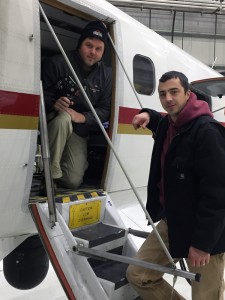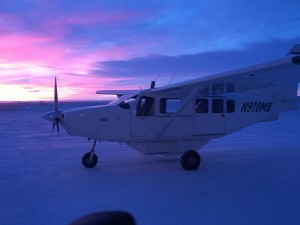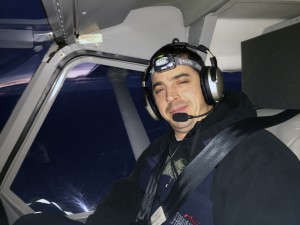When the tundra freezes, the North Slope gets busy. It’s the travel season, the time of year when oil producers can put in ice roads and move heavy equipment over the frozen ground.
But before any of that can happen, one task comes first: looking for polar bears.
On the North Slope, bears have the right of way.

Each winter, pregnant females den in snow drifts to give birth – and federal regulations require all human activity to remain at least a mile away.
Cubs are born small and blind. If a mother is disturbed and leaves her den early, the cubs likely won’t survive.
That means, every winter, millions of dollars of work on the North Slope must be routed around any known dens.
And that’s where Justin Blank and Steve Wackowski come in. The pair work for Fairweather LLC, which has carved out a niche providing unconventional services to the oil and gas industry, from remote medics to polar bear guards.
Blank and Wackowski fly surveys each winter on the North Slope, looking for dens near any planned projects.
They do this using an infrared camera. At his Anchorage office, Blank pointed out a photo.
“It looks like R2D2 upside down, right?” he said.
The camera rotates on the underside of the plane, controlled by a joystick.
Waldholz: “It looks like a video game controller!”
Blank: “I tell me mom this: You always said that video games wouldn’t help me in life – and you were wrong, mom.”
The sensor can pick up a fraction of a degree difference in heat, and it produces images that look like black and white TV. White means hot. Warmer regions – like a road, or a river – show up as bright spots in a muddy gray landscape. Tracks where a vehicle or even a bear has passed will linger days later, just slightly warmer than the surrounding snow.

But it takes a trained eye to know what you’re seeing. Blank is one of the only people outside the U.S. Fish and Wildlife Service good enough to identify a den.
“What you’re seeing here is a vent hole,” he said, pointing out a bright spot in the footage. “The bear’s body heat and breath, and everything in there, is creating a nice, strong signature, that allows us to identify where it is.”
Wackowski said it’s almost impossible to see while flying.
Wackowski: “It glows like an orb and it catches your eye. But when you’re in an airplane, and you’re on hour three, looking at three hours of black and white video, everything kind of blends together, right?”
Blank: “Yeah.”
The pair will fly for three hours in the morning, and three hours in the afternoon, averaging 800 miles a day for a couple weeks. Most days, they won’t find anything. In a big year, Blank said, he’ll log maybe eight suspected dens — total.
That’s a lot of time and expense for eight polar bears. But, Blank said, for companies on the Slope, it’s worth it. If a den turns up in the way of an ice road, it’s the ice road that has to move. That’s time consuming and costly.
All those hours in the air mean that when you do find something, it’s pretty exciting.
Wackowski: “Is that it?”
Blank: “I don’t think so…”
Wackowski: “Yeah that’s it! Oh, tell me that’s not my first den! There’s tracks there, there’s a hole.”
Blank: “That’s a good maybe, man.”
Wackowski learned to operate infrared sensors flying unmanned aerial vehicles in Iraq and Afghanistan for the Air Force. The technology the team uses was originally developed by the military to see at night.
“I’m using some of the skills I learned in the military to go find bad guys, and now I get to use it to protect wildlife at home, these incredible critters that we share the environment with,” Wackowski said. “To me, it’s a really fulfilling mission.”
That mission has gotten more important in recent years, because there are more bears than ever denning onshore.
Christopher Putnam oversees the den surveys for the U.S. Fish and Wildlife Service.
“The pattern of polar bear denning has completely reversed itself within a matter of a few decades,” he said.
Thirty years ago, two thirds of southern Beaufort Sea polar bears denned on sea ice. Now, two thirds are denning on shore, according to research from the U.S. Geological Service. That means more contact with people – both local communities and the oil industry.
Waldholz: “Why is that? What’s driving them inland?”
Putnam: “Who knows. There’s something about the sea ice they don’t like.”
Bears usually den where there’s jumble ice to catch snow drifts, Putnam said, and it might be that those spots are no longer stable enough to last through the three or so months of the denning season. But one thing is clear.

“This is one of the observable impacts of climate change,” Putnam said. “It’s not a model, it’s not a prediction. We’re seeing it happen.”
Back at Fairweather, Blank called me over to watch one last piece of video.
Waldholz: “That spot, is that a bear? That looks like bear!”
The video showed a big empty, gray field, with one bright spot – a bear, loping along over the landscape, alone.
Rachel Waldholz covers energy and the environment for Alaska's Energy Desk, a collaboration between Alaska Public Media, KTOO in Juneau and KUCB in Unalaska. Before coming to Anchorage, she spent two years reporting for Raven Radio in Sitka. Rachel studied documentary production at the UC Berkeley Graduate School of Journalism, and her short film, A Confused War won several awards. Her work has appeared on Morning Edition, All Things Considered, and Marketplace, among other outlets.
rwaldholz (at) alaskapublic (dot) org | 907.550.8432 | About Rachel




